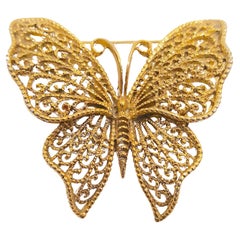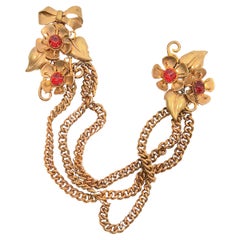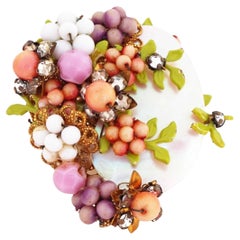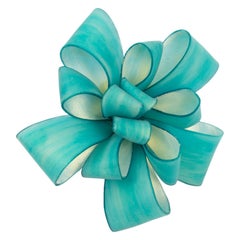Frank Hess for Miriam Haskell Brooches
6
to
5
1
6
3
3
30
428
417
392
236
4
2
4
3
2
2
2
3
1
1
Creator: Frank Hess for Miriam Haskell
MiriamHaskell WWII Era FrankHess GoldGiltCast Filigree Butterfly Brooch
By Frank Hess for Miriam Haskell
Located in Chicago, IL
A child of the Art Nouveau period, Miriam Haskell loved its butterfly design-motifs, which are found in many pieces of costume jewelry by her first designer Frank Hess. His butterfly...
Category
1940s American Art Nouveau Vintage Frank Hess for Miriam Haskell Brooches
Materials
Yellow Gold, Gilt Metal, Base Metal
MiriamHaskell c1929 FrankHess Rare FurClips GoldGiltBrass 3ChainFloraBow Lariat
By Frank Hess for Miriam Haskell
Located in Chicago, IL
As one of Miriam Haskell's earliest fur clips from the late 1920s, these two Russian-gold gilt mostly brass brooches by her first designer Frank Hess are tethered as a lariat by thre...
Category
1930s American Baroque Revival Vintage Frank Hess for Miriam Haskell Brooches
Materials
Yellow Gold, Brass, Gilt Metal
MiriamHaskell WWII FrankHess PurpleGlassFlowersGoldLeaves WiredPlasticBackBrooch
By Frank Hess for Miriam Haskell
Located in Chicago, IL
Beginning in 1939, Miriam Haskell asked her first designer Frank Hess to sparingly use metal in the costume-jewelry collections during WWII while war materials were needed. So their ...
Category
1940s American Baroque Revival Vintage Frank Hess for Miriam Haskell Brooches
Materials
Mixed Metal
MiriamHaskell 1930s FrankHess TripleSeashell RussianGilt Flora WoodLeaf Brooch
By Frank Hess for Miriam Haskell
Located in Chicago, IL
This early Miriam Haskell lacquered-shell and brass-decorated clip brooch was created by Frank Hess, her first designer since 1926. The 1930s brooch features three seashells supporti...
Category
1930s American Baroque Revival Vintage Frank Hess for Miriam Haskell Brooches
Materials
Gold, Base Metal, Brass, Gilt Metal
Mother of Pearl & Pastel Beaded Floral Cluster Brooch By Miriam Haskell, 1940s
By Frank Hess for Miriam Haskell
Located in McKinney, TX
- Vintage item
- Collectible costume jewelry piece from the '40s
- Extremely rare, early design from the iconic designer Miriam Haskell
- 2" x 1.5"
- Mother of Pearl disc
- Past...
Category
1940s American Modern Vintage Frank Hess for Miriam Haskell Brooches
A striking gilt and topaz paste 'sunburst' brooch, Miriam Haskell, USA, 1930s.
By Frank Hess for Miriam Haskell
Located in Greyabbey, County Down
A large and strong 'sunburst' brooch designed by Frank Hess, from Miriam Haskell's early days, in the 1930s. As with many pieces, this stylised dynamic flower design is unsigned, and...
Category
1930s American Vintage Frank Hess for Miriam Haskell Brooches
Materials
Gilt Metal
Related Items
Crown Trifari Vintage 1950s Bouquet Floral Dandelion Leaf Pearl Cluster Brooch
By Alfred Philippe for Trifari
Located in Wokingham, England
Very good condition. 100% Genuine.
Very light colour loss or light scratches, barely noticeable. The leaf part is some a little loose, not any problems.
A very beautiful brooch, s...
Category
1950s American Art Nouveau Vintage Frank Hess for Miriam Haskell Brooches
Materials
Gold Plate
Free Shipping
W 1.03 in L 1.82 in
Cilea Paris Oversized Turquoise Resin Ribbon Pin Brooch
By Ciléa
Located in Atlanta, GA
This exquisite brooch from Cilea Paris is a piece of art to wear, crafted by hand with skillful attention to detail. Made with high-quality resin, it features a beautiful turquoise r...
Category
Early 2000s French Modern Frank Hess for Miriam Haskell Brooches
John Brogden Shell Cameo Brooch and Earrings, English, circa 1870
By John Brogden
Located in London, GB
Antique shell cameo brooch and earrings by John Brogden, English, circa 1870. A yellow gold suite of jewellery, the brooch composed of a horizontally situated oval Bull’s Mouth shell cameo of the Greek goddess Selene riding a serpentine dragon in a rubover collet setting, encircled by a conforming frame of gold beading and twisted gold wire punctuated with four gold palmette form plaques engraved and decorated with dark blue enamel and placed at the cardinal points, the reverse mounted with a hinged pin and scroll clasp, the earrings each composed of a vertical oval Bull’s Mouth shell cameo engraved with a bust length portrait of Selene with crescent-set headdress, encircled by a conforming frame matching that of the brooch with the addition of a pendant decoration composed of a horizontal bar of gold beading and twisted gold wires suspending gold link chains graduated from centre and ending in conical gold elements, the reverses mounted with French wire fittings, all in a fitted red leather case, the interior marked ‘FIRST CLASS PARIS MEDAL/ 1855.1867.1851/ PARIS FIRST CLASS & LONDON PRIZE MEDALS/ JOHN BROGDON/ Goldsmith/ MANUFACTORY/ 16, Henrietta St. Covent Garden/ London’.
The cameo—defined as a gem, usually either a mineral or a shell, upon which a design has been carved in relief—is believed to have originated in Hellenistic Greece, during the third century BC. These miniature sculptures, at that time confined to the medium of hardstone, are thought to have been made with the primary purpose of personal adornment. The same practice of mounting cameos in jewellery was then continued by the Ancient Romans, and they are known to have been worn by many a Roman emperor.
After the fall of Rome the fashion for cameos went into a decline, until it was again revived during the Renaissance period, brought about by a keen interest in the ancient world. At this time both antique and contemporary cameos were mounted in jewellery, as well as collected as objet d’art. The art of cameo cutting was revived in Italy, where it would remain a centre for the coming centuries. Again there was a lull in interest in carved gemstones, until the Neoclassical revival of the eighteenth century, largely stimulated by the discoveries of the ancient Roman cities of Pompeii and Herculaneum. As with the Renaissance, antique specimens were generally prized over modern cameos, and the worldliest men in Europe held them among their collections of art and antiques. That said, carving centres in Rome and Torre del Greco (near Naples) in Italy were established in response to the demand of the Grand Tourists, who travelled to Italy and Greece to become educated in the wonders of the ancient world. It was at this time that shell cameos, mostly made in Torre del Greco due to its proximity to the sea, became more popular, owing to the relative ease in carving shell over hardstone. In addition to Rome, hardstone cameos also became a specialty of Idar Oberstein, Germany, which had a long history with both the gem mining and cutting trade.
In a shift away from the collector’s cases of the previous century, the nineteenth century saw a strengthening in the fashion for wearable cameos. After the Empress Josephine donned a cameo-set suite of jewellery at the coronation of Napoleon in 1804, cameo jewellery became all the rage. Napoleon played a further hand in promoting the art by establishing a gemstone carving school in Paris, inspired by his appreciation for the arts of the ancient world. By the mid-nineteenth century shell cameos, in part due to their lightness compared with hardstone cameos, were the height of fashion. Large shell cameos as well as hardstone cameos were set into contemporary mounts, often as suites of jewellery. Some of the best cameos of the nineteenth century—carved by a select group of recognized carvers—were set into revivalist mounts, corresponding to the subject matter.
In Victorian England cameo jewellery was particularly prized, due in part to the fact that the Queen owned and wore a number of cameo jewels. One example which can often be seen in official portraits is the Badge of the Order of Victoria and Albert, carved by Tommaso Saulini of Rome, who also produced cameos for the maker of the present suite, John Brogden. To meet demand some carvers set themselves up in London, including William Schmidt, a German carver from Idar Oberstein, who produced cameos for top London jewellers, including Brogden, Carlo Giuliano and Child & Child. In fact, Schmidt purports to have been the first to carve cameos out of opal, which Brogden reportedly displayed in the Paris Exhibition of 1878. An extant example, now in the collection of the British Museum, was set by the Giuliano firm.
Regarding subject matter, cameos throughout time have been largely figural, from bust length profile portraits to scenes with multiple full-length figures, and sometimes animals. Ancient Greek and Roman cameos often depicted mythological scenes as well as contemporary figures. During the Renaissance, mythological scenes were popular, often taken directly from ancient sculpture, as well as portraits of notable contemporary figures. During the eighteenth and nineteenth centuries, due to the revivalist styles, both Renaissance and Classical subjects were copied and set into matching (and sometimes unmatching) revivalist mounts. From the Renaissance through the Victorian era, being able to recognize the source of the carving in a cameo was a mark of erudition, revealing in the wearer knowledge of Classical art.
As mentioned, the present cameo parure...
Category
1870s English Victorian Antique Frank Hess for Miriam Haskell Brooches
Materials
Yellow Gold
Irena Jaworska, Line Vautrin School Resin and Orange Mirror Mosaic Pin Brooch
Located in Atlanta, GA
This adorable Irena Jaworska Talosel or resin pin brooch features a dimensional geometric fan shape in black resin framing, topped with a mosaic of mirr...
Category
1970s French Modernist Vintage Frank Hess for Miriam Haskell Brooches
Free Shipping
W 3.27 in L 2.25 in
Cartier New York GIA Certified 11.24 Carat Old Mine Cushion Diamond Brooch
By Cartier
Located in Miami, FL
Magnificent Cartier Art Deco Platinum and Diamond Brooch featuring a matching pair of important Old Mine Cut Diamonds weighing 5.60 carats and 5.64 carats. Both accompanied by a GIA report stating that they are H color VS1 and H color VS2 clarity. This brooch comes with an Expertise letter from IAJA (international Antique Jewelers...
Category
1930s American Art Deco Vintage Frank Hess for Miriam Haskell Brooches
Materials
Diamond, Platinum
Cartier Paris Yellow Cognac White Diamond Panther Brooch
By Cartier
Located in New York, NY
Cartier Paris Yellow Cognac White Diamond Panther Brooch
Cartier describes the Panther as 'The Panther is Cartier’s iconic animal: a wild, untamable anim...
Category
2010s French Modern Frank Hess for Miriam Haskell Brooches
Materials
White Diamond, 18k Gold
Cartier Paris Vintage 1950s Diamond Stylized Floral Pin
By Cartier
Located in New York, NY
Cartier Paris Vintage 1950s Diamond Stylized Floral Pin
A fine signed “Cartier”; circa 1950s platinum brooch, designed as three leaves, set with...
Category
1950s French Art Deco Vintage Frank Hess for Miriam Haskell Brooches
Materials
Diamond, 18k Gold, Platinum
Rare Trifari large 3.25" fascia red aurora borealis margarita flower pin brooch
By Trifari
Located in New York, NY
This Trifari pin is a stunning piece dating from the mid 1950s. It has the crown Trifari mark with c in a circle copyright mark dating seen on pieces from 1955 to 1969. This 3.25 inc...
Category
1950s American Vintage Frank Hess for Miriam Haskell Brooches
Materials
Crystal, Gold Plate, Base Metal
Free Shipping
D 0.5 in Dm 3.25 in L 15 in
David Webb Diamond, Pearl Brooch
By David Webb
Located in New York, NY
DAVID WEBB Diamond, Pearl Brooch
Platinum clip brooch, set with round brilliant-cut diamonds, and three cultured pearls.
Pearl dimensions approx. – 24.8 by 15.1 by 15.1 mm
22.1 by 15...
Category
1980s American Vintage Frank Hess for Miriam Haskell Brooches
Materials
Diamond, Pearl, Platinum
Carved Coral Buddha Pendant in 18k Gold Set with Diamonds, Emeralds and Rubies
Located in Honolulu, HI
MAGNIFICENT large vintage Buddha pendant brooch in 18K yellow gold. This gorgeous pendant features a stunning Buddha carved in natural coral set...
Category
Late 20th Century Unknown Frank Hess for Miriam Haskell Brooches
Materials
Coral, Diamond, Emerald, Ruby, 18k Gold
Line Vautrin "La Manif" Gilt Bronze Brooch
By Line Vautrin
Located in New York, NY
Gilt brooch by Line Vautrin (1913-1997), circa 1945-46. The design is known as
...
Category
1950s French Artisan Vintage Frank Hess for Miriam Haskell Brooches
Materials
Bronze, Gilt Metal, Gold Plate, Brass
Christian Lacroix Jeweled Pin Brooch, Floral with Pearls
By Christian Lacroix
Located in Atlanta, GA
This is one of the oldest pieces of Christian Lacroix Paris Jewelry we have ever had. This stunning pin brooch belongs to the first jewelry collection ma...
Category
1980s French Romantic Vintage Frank Hess for Miriam Haskell Brooches
Materials
Gilt Metal
Frank Hess For Miriam Haskell brooches for sale on 1stDibs.
Find a range of Frank Hess for Miriam Haskell brooches available on 1stDibs. Each of these unique items was designed with extraordinary care, often using gilt metal. We have 6 pieces in this collection as well as a number of other designs by this jeweler. Revival and Art Nouveau are among the most popular styles of Frank Hess for Miriam Haskell brooches available on 1stDibs. While this collection reflects work that originated over various time periods, most of these items were designed during the 20th century. If you’re looking for additional options, many customers also consider brooches by Trio, and Castellani. Prices for Frank Hess for Miriam Haskell brooches can differ depending upon gemstone, time period and other attributes. On 1stDibs, the price for these items starts at $329 and tops out at $2,250, while pieces like these, on average, can sell for $1,495.
Recently Viewed
View AllMore Frank Hess for Miriam Haskell Jewelry & Watches
Frank Hess for Miriam Haskell Necklaces
Frank Hess for Miriam Haskell Earrings
Frank Hess for Miriam Haskell Bracelets
Frank Hess for Miriam Haskell Clip-on Earrings
Frank Hess for Miriam Haskell Beaded Necklaces
Frank Hess for Miriam Haskell Beaded Bracelets
Frank Hess for Miriam Haskell Chain Necklaces
Frank Hess for Miriam Haskell Dangle Earrings
Frank Hess for Miriam Haskell Choker Necklaces
Frank Hess for Miriam Haskell Drop Necklaces
Frank Hess for Miriam Haskell Pendant Necklaces







